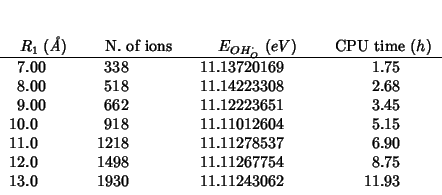2000-01-20: influence of region 1 radius on
Explorative calculations on the
![]() system: input
file was constructed after the one sent by Ronny. Energy of the
system: input
file was constructed after the one sent by Ronny. Energy of the
![]() defect at increasing region 1 radius.
defect at increasing region 1 radius.
Representative input file:
opti conp defect regi_before #conp defect single dump every 1 gulp-09.dump maxcyc 200 cutb 3.0 # what does this mean? Ronny uses it. title adjusting region 1 radius end cell 5.274196 5.274196 5.274196 90.000000 90.000000 90.000000 size 09.0 20.00 centre 0.251 0.249 0.25 impurity O2 core 0.25 0.25 0.25 interstitial H2 core 0.44 0.25 0.25 fractional ############ # Cores ############ Ce4 core 0.000000 0.000000 0.000000 -3.700000 0.50 Zr core 0.000000 0.000000 0.000000 2.65 0.50 O1 core 0.250000 0.250000 0.250000 0.07700 1.00 ############ # Shells ############ Ce4 shel 0.000000 0.000000 0.000000 7.700000 0.50 Zr shel 0.000000 0.000000 0.000000 1.35 0.50 O1 shel 0.250000 0.250000 0.250000 -2.07700 1.00 space 225 ######################### # Shell-core charges ######################### species Ce3 shel 7.700000 Ce3 core -4.700000 O2 core -1.4263 H2 core 0.4263 ######################### # Short range potentials ######################### buck Ce4 shel O1 shel 1986.830000 0.351070 20.40000 0.0 15.000 buck Ce3 shel O1 shel 1731.61808 0.36372 14.43256 0.0 15.000 buck Zr shel O1 shel 985.869000 0.376000 0.00000 0.0 15.000 buck O1 shel O1 shel 22764.300000 0.149000 27.89000 0.0 15.000 buck O2 core O1 shel 22764.300000 0.149000 27.89000 0.0 15.000 buck H2 core O1 shel 311.970 0.35 0.0 0.0 15.000 morse H2 core O2 core 7.05250 2.19860 0.9485 1.0 0.0 2.0 buck Ce4 shel O2 core 1986.830000 0.351070 20.40000 0.0 15.000 buck Zr shel O2 core 985.869000 0.376000 0.00000 0.0 15.000 ######################### # Spring parameters ######################### spring Ce4 291.750000 spring Ce3 291.750000 spring Zr 169.617000 spring O1 27.29
The following table lists the formation energies for the
![]() defect (no
defect (no ![]() addition) at increasing region 1
radius (region 2a radius is fixed at
addition) at increasing region 1
radius (region 2a radius is fixed at
![]() ):
):

Taking the value of
![]() for
for
![]() ,
,
![]() from
previous work Balducci et al. (1997) and
from
previous work Balducci et al. (1997) and
![]() from Glockner et al. (1999), the energy change for water incorporation:
from Glockner et al. (1999), the energy change for water incorporation:
is calculated to be:
![]() , which
is extremely higher than the values reported in Glockner et al. (1999).
, which
is extremely higher than the values reported in Glockner et al. (1999).